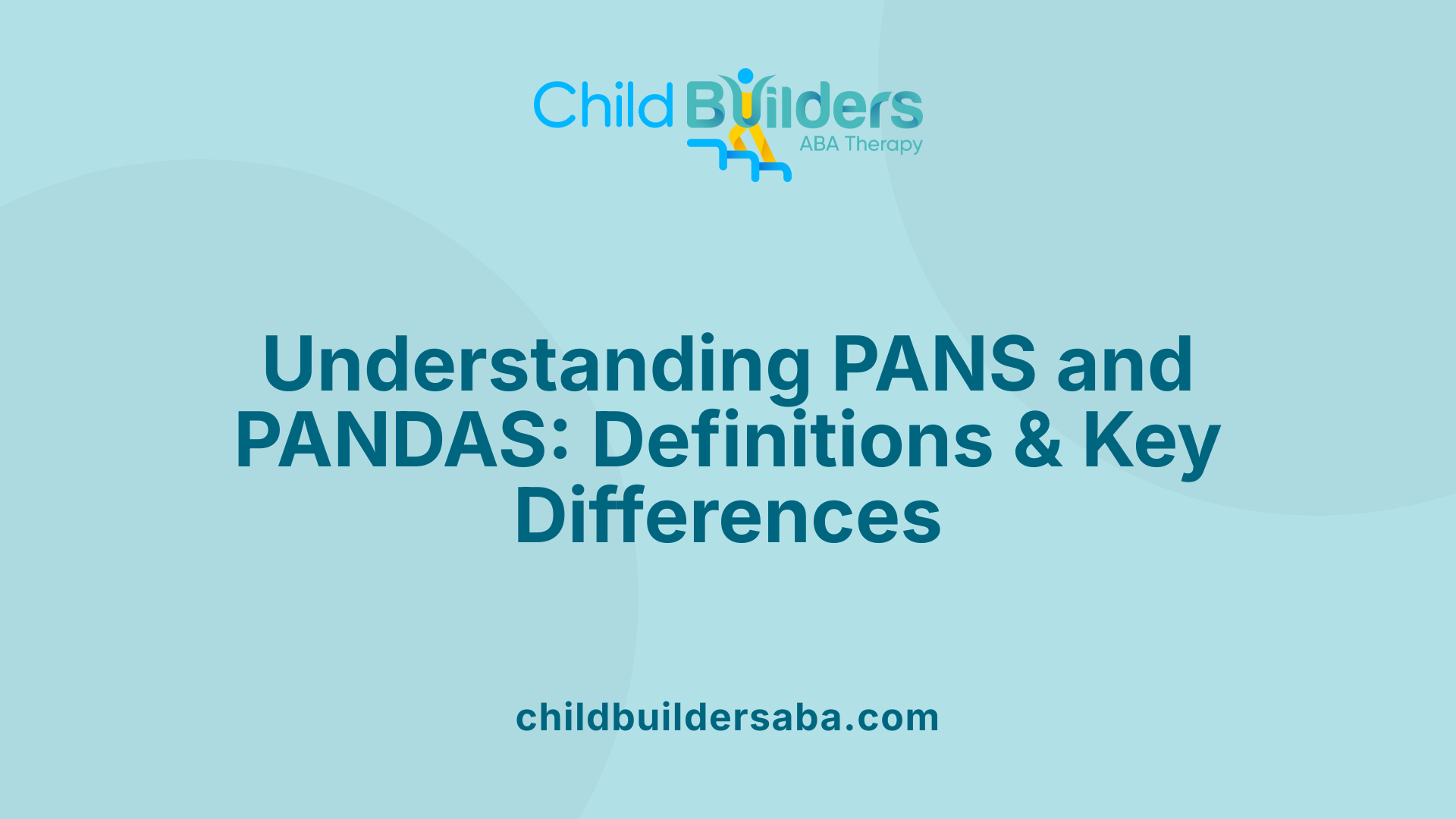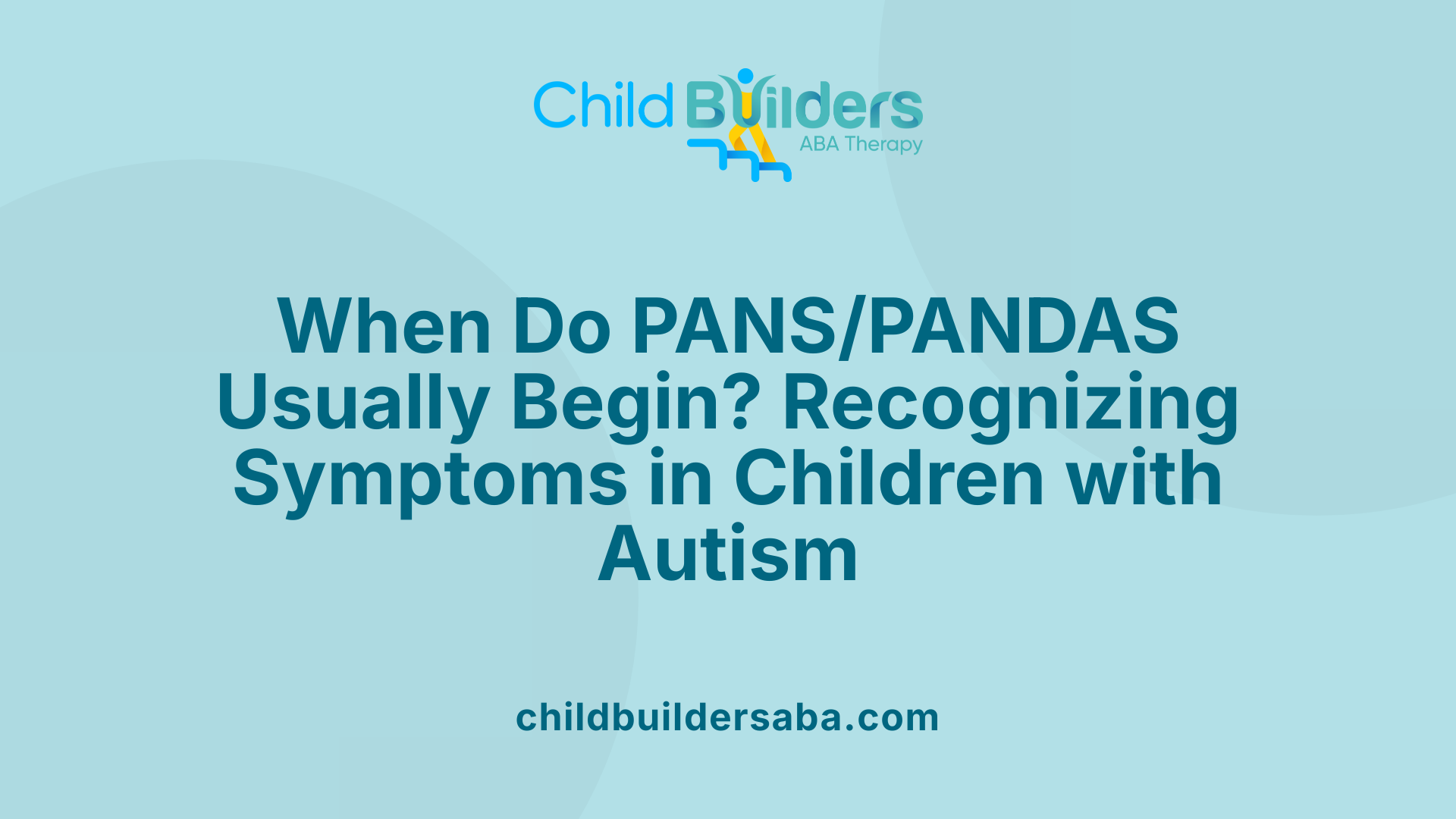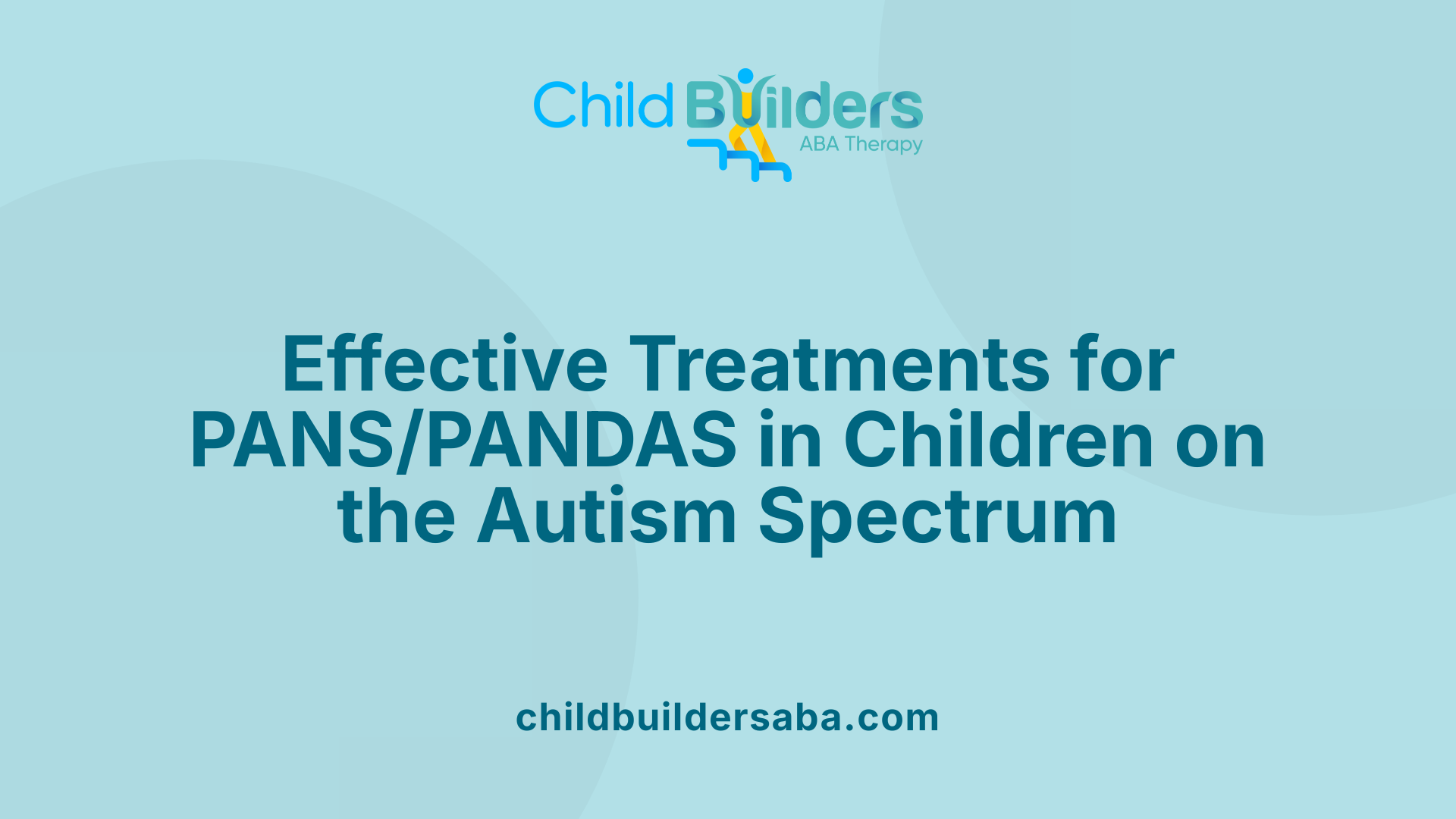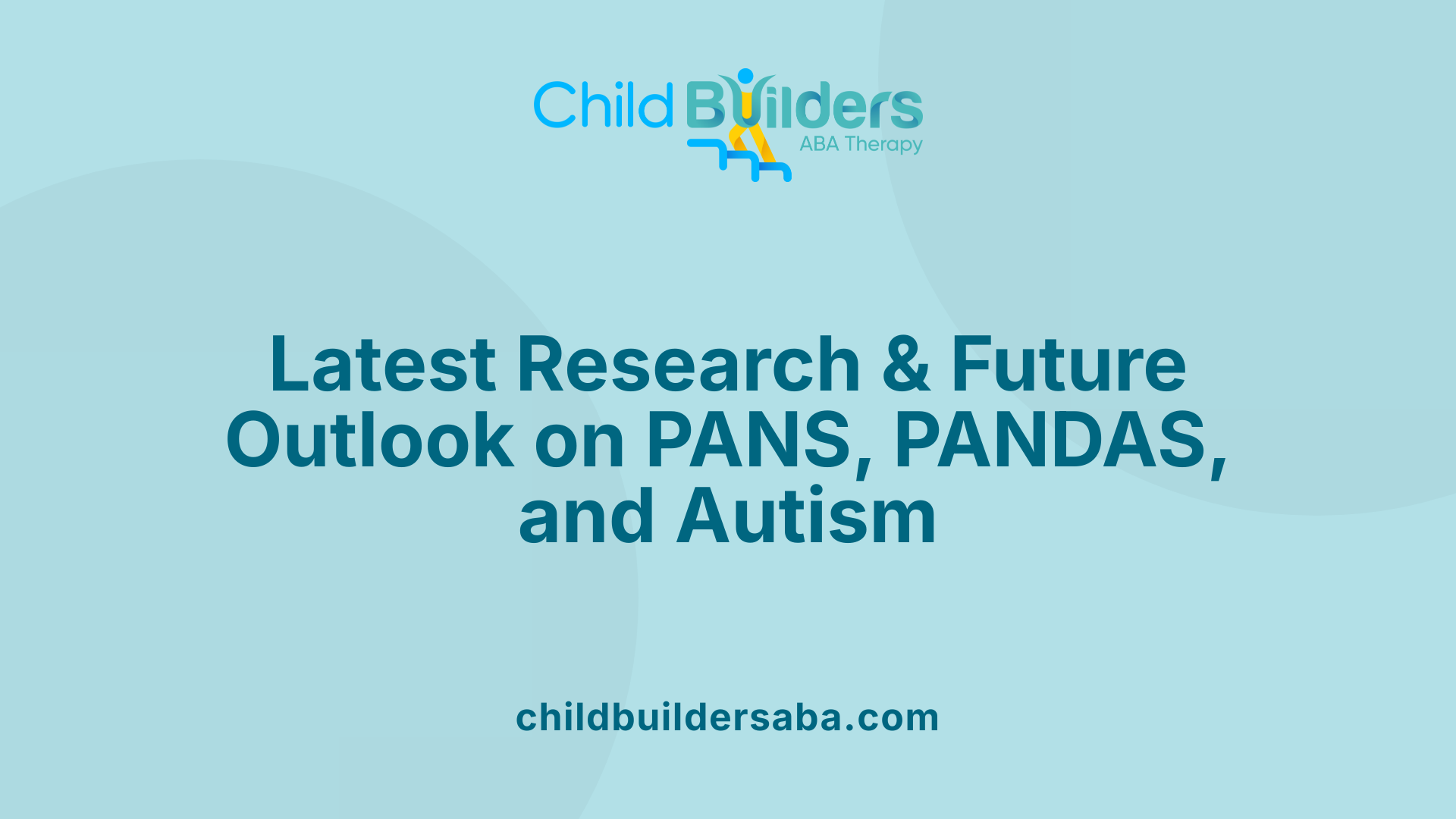PANS/PANDAS in Children with Autism

Understanding a Rare but Significant Intersection of Autoimmune and Neuropsychiatric Conditions in Autism
PANS (Pediatric Acute-onset Neuropsychiatric Syndrome) and PANDAS (Pediatric Autoimmune Neuropsychiatric Disorders Associated with Streptococcal Infections) are complex neuropsychiatric conditions that can complicate the diagnosis and management of children with autism. These syndromes are characterized by sudden, severe onset of symptoms like OCD, tics, and behavioral regression—symptoms that often mimic or overlap with typical autism features. While generally affecting children between 3 and 12 years old, PANS/PANDAS remain relatively rare in children with autism, and their diagnosis requires careful differentiation owing to symptom overlap. Early recognition and treatment are vital because they dramatically influence prognosis, reducing the risk of permanent neurological or psychological impact.
Understanding PANS and PANDAS: Definitions and Differences

What are PANS and PANDAS?
PANS, or Pediatric Acute-onset Neuropsychiatric Syndrome, is characterized by a sudden and dramatic emergence of neuropsychiatric symptoms such as obsessive-compulsive behaviors or eating restrictions. Accompanying symptoms often include anxiety, behavioral regression, mood swings, irritability, sensory or motor abnormalities, and physical signs like sleep disturbances and urinary issues. PANDAS (Pediatric Autoimmune Neuropsychiatric Disorders Associated with Streptococcal Infections) is a subset of PANS, specifically triggered by Group A Streptococcus bacteria, such as in strep throat.
In children, PANDAS manifests with rapid onset of tics, obsessive behaviors, mood swings, and regression following a streptococcal infection. While both conditions predominantly affect children between ages 3 and 12, the typical onset occurs around ages 7 or 8. Notably, PANDAS is linked to an autoimmune process where antibodies mistakenly attack brain regions, leading to neuropsychiatric symptoms.
How do PANS and PANDAS differ?
The main distinction lies in their triggers. PANS can result from various infectious or environmental factors, including viruses and metabolic issues. PANDAS, however, is specifically associated with streptococcal infections. Autoimmune mechanisms are central to both, but PANDAS involves immune responses directed explicitly against brain tissues following strep infections.
Some overlap exists, with symptoms like tics, OCD, irritability, and behavioral regression common to both. Diagnostic challenges arise especially in children with existing autism, as symptoms can overlap and make clear distinction difficult.
Trigger factors and autoimmune mechanisms
PANS often results from an inflammatory or immune response triggered by infections like M. pneumoniae or viral agents, or even environmental exposures. Its autoimmune component involves antibodies that may target neuronal tissue yet are not specific to one pathogen.
PANDAS develops when Streptococcus bacteria provoke production of autoantibodies that cross-react with brain tissues, particularly targeting the basal ganglia. These autoantibodies can disrupt neuronal signaling, leading to motor symptoms like tics or movement abnormalities.
Research indicates that blood-brain barrier disruptions facilitate autoantibody entry into the brain, intensifying neuroinflammation. Studies also show that these immune responses may be temporary or recurrent, resulting in episodic or persistent symptoms.
| Condition | Main Trigger | Autoimmune Target | Typical Symptoms | Diagnostic Challenges |
|---|---|---|---|---|
| PANS | Various infections/environmental factors | Autoantibodies; blood-brain barrier involvement | OCD, tics, behavioral regression, sleep disturbances | Overlap with autism, other neuropsychiatric conditions |
| PANDAS | Streptococcus bacteria | Brain tissues in basal ganglia | Tics, obsessive behaviors, mood swings, regression | Similar to PANS; specific pathogen identification needed |
Understanding the immune component and autoimmune processes is crucial as they inform treatment strategies, which may include antibiotics, immune therapies, and behavioral interventions.
Age, Onset, and Typical Symptoms of PANS/PANDAS in Children with Autism

How old are children when PANS/PANDAS typically begins?
Most children develop PANS or PANDAS between the ages of 3 and 12, with the average age being around 7 to 8 years old. Although these conditions are primarily seen in school-aged children, they can occur at any age within this range. While rare, children with autism can also be affected by PANS/PANDAS, especially when behavioral changes suddenly appear.
What symptoms are common in children with autism affected by PANS/PANDAS?
Children with autism who also develop PANS or PANDAS often experience a sudden and noticeable change in behavior. These children may suddenly exhibit obsessive-compulsive behaviors, develop new motor or vocal tics, or show regression in previously acquired skills. Additional symptoms include emotional instability such as irritability, mood swings, and anxiety.
Sleep disturbances are very common, occurring in about 80% of cases, along with urinary issues like incontinence or frequent urination. Many also experience eating problems, including loss of appetite or sudden food refusal, and some develop new sensory or motor abnormalities.
It is important to note that these symptoms can develop rapidly, often following infections like strep throat, and represent a sharp contrast to the child's typical autistic behavior.
How does PANS/PANDAS overlap with autism symptoms?
Since autism itself involves repetitive behaviors and social challenges, diagnosing PANS/PANDAS in children with autism can be quite challenging. The symptoms of PANS or PANDAS—such as sudden irritability, ritualistic behaviors, or regression—may resemble or overlap with autism features.
However, the key differences include the rapid onset and fluctuation of symptoms, especially following infections. Recognizing a sudden change, particularly with new tics, sleep problems, urinary issues, or aggression, is crucial for timely diagnosis and treatment.
In summary, in children with autism, a rapid, new development of behaviors like OCD, tics, sleep difficulties, or urinary problems—particularly after infection—should prompt evaluation for PANS/PANDAS, as addressing the underlying cause can significantly improve outcomes.
| Aspect | Typical Age/Characteristics | Overlap/Notes |
|---|---|---|
| Onset | 3-12 years, average 7-8 years | Can occur at any age within this range; rare in autism |
| Symptoms | Sudden OCD, tics, regression, irritability, sleep and urinary issues | Sudden changes contrast with autism’s gradual development |
| Diagnostic Challenge | Overlap with autism behaviors | Rapid onset post-infection is a differentiator |
Understanding these patterns helps clinicians distinguish between typical autism behaviors and those caused by PANS/PANDAS, enabling targeted treatment.
Diagnostic Challenges and Approaches in Children with Autism

How is PANS/PANDAS diagnosed and differentiated from other conditions in children with autism?
Diagnosing PANS (Pediatric Acute-onset Neuropsychiatric Syndrome) and PANDAS (a subtype linked to streptococcal infections) in children with autism requires careful clinical evaluation. The process looks for a sudden onset or rapid worsening of neuropsychiatric symptoms like obsessive-compulsive behaviors, tics, behavioral regression, sleep disturbances, and somatic issues such as urinary or motor abnormalities.
Physicians assess the timeline of symptom development, as PANS/PANDAS symptoms typically appear within days or weeks, unlike the gradual progression typical of autism spectrum disorder (ASD). Laboratory tests like throat swabs for strep, blood tests for strep titers, and autoimmune markers support the diagnosis but are not definitive on their own.
Differentiation relies on recognizing the abrupt, fluctuating nature of symptoms following an infection and ruling out other neurological or medical causes. This process involves detailed medical history, observation, and exclusion of other possibilities. In children with autism, identifying these symptoms can be challenging because many overlap with existing autism features.
Why is it challenging to diagnose PANS/PANDAS in children with autism?
Diagnosing PANS/PANDAS in children with autism is complicated due to overlapping symptoms. Features such as irritability, repetitive behaviors, sensory sensitivities, and mood swings are common in both conditions. When behaviors suddenly worsen or new symptoms develop, clinicians must distinguish whether this is an exacerbation of autism or a separate, infection-triggered process.
Furthermore, the absence of specific biomarkers makes diagnosis heavily reliant on clinical judgment. Children with autism may already display some of the signs of PANS/PANDAS, leading to missed or delayed diagnosis. This overlap emphasizes the importance of careful monitoring for sudden behavioral shifts, especially if they coincide with signs of infection like sore throat or fever.
Recognizing these challenges helps ensure timely and appropriate treatment, reducing the risk of misdiagnosis and improving outcomes for affected children.
More about the process
A comprehensive understanding of PANS/PANDAS involves awareness of the possibility of co-occurrence with autism and the importance of thorough assessment. Both laboratory evaluation and clinical observation are essential tools. The goal is to differentiate between autism-related behaviors and those caused by an autoimmune or infectious process, allowing for targeted treatment strategies.
Search Query for Further Information: "Differential diagnosis of PANS/PANDAS in children with autism"
| Aspect | Features | Diagnostic Considerations |
|---|---|---|
| Onset | Sudden/rapid | Develops over days/weeks, unlike ASD |
| Symptoms | OCD, tics, regression, somatic issues | Fluctuate, often post-infection |
| Laboratory Tests | Throat culture, blood autoantibodies | Supportive but not definitive |
| Overlap | Repetitive behaviors, irritability | Requires careful clinical judgment |
| Challenges | Symptom overlap, no specific biomarkers | Emphasis on history, observation |
Understanding these diagnostic nuances enhances proper intervention and management for children navigating these complex conditions.
Treatment Strategies and Management in Children with Autism and PANS/PANDAS

What are the treatment options for children with autism affected by PANS/PANDAS?
Managing PANS/PANDAS in children with autism requires a comprehensive and individualized approach. Healthcare providers often recommend a combination of therapies aimed at addressing both the infection and the immune response.
Antibiotics, such as penicillin, amoxicillin-clavulanate, or azithromycin, are commonly used to target and eliminate streptococcal bacteria, especially in PANDAS cases where the infection is clearly identified. For immune dysregulation, treatments like corticosteroids, intravenous immunoglobulin (IVIG), or plasmapheresis may be prescribed for severe or ongoing symptoms.
In addition to immune therapies, anti-inflammatory agents such as NSAIDs or antioxidant supplements can help reduce brain inflammation. Behavioral treatments play a vital role too, with cognitive-behavioral therapy (CBT) combined with exposure and response prevention (ERP) being effective in managing compulsions and anxiety.
Dietary adjustments, nutritional supplements, and supportive care are often integrated to promote overall well-being. The specific treatment plan should be devised by a multidisciplinary team experienced in autism and neuroimmune disorders to ensure safety and maximum benefit.
Are there debates or controversies surrounding PANS/PANDAS and autism?
The relationship between PANS/PANDAS and autism is still a topic of ongoing debate within the medical community. A significant point of contention is the difficulty in distinguishing these syndromes because their symptoms often overlap, including obsessive behaviors, irritability, and regression.
Some researchers question whether PANS/PANDAS represent distinct autoimmune conditions or are variations of other neuropsychiatric disorders such as autism. Additionally, the lack of reliable biomarkers complicates diagnosis and understanding of these conditions.
Most controversy centers on the prevalence and the underlying mechanisms, with some experts urging caution in attributing autism regression to autoimmune causes without robust evidence. However, recognizing potential immune contributions remains crucial for personalized treatment approaches.
Further research is necessary to establish clear diagnostic criteria, understand the pathogenesis, and develop standardized treatment protocols, which will help resolve some of the current uncertainties.
More about treatment options for PANS/PANDAS in children with autism
| Treatment Type | Description | Notes |
|---|---|---|
| Antibiotics | Used to eliminate streptococcal infection (penicillin, azithromycin, amoxicillin) | Most effective when infection is identified; supports immune recovery |
| Immunomodulatory therapies | Corticosteroids, IVIG, plasmapheresis | For severe, persistent, or recurrent symptoms; requires specialist oversight |
| Behavioral interventions | CBT, ERP (Exposure and Response Prevention) | Helps manage compulsive behaviors and anxiety; adaptable for children with autism |
| Supportive care and diet | Nutritional support, antioxidant supplements, proper sleep hygiene | Enhances overall health and mitigates inflammation |
| Family and educational support | Psychoeducation, behavioral strategy training | Essential for consistent management at home and school |
Recognizing the complexity of these conditions highlights the need for an integrated, multidisciplinary approach. Early intervention and tailored treatment plans can significantly improve outcomes for children affected by PANS/PANDAS, even within the autism spectrum.
Current Scientific Perspectives and Future Directions
 Research into PANS and PANDAS highlights complex interactions between infections, immune responses, and the nervous system, especially regarding their impact on children with autism. While these conditions do not cause autism, their overlapping symptoms and underlying mechanisms can influence the severity and presentation of autistic behaviors.
Research into PANS and PANDAS highlights complex interactions between infections, immune responses, and the nervous system, especially regarding their impact on children with autism. While these conditions do not cause autism, their overlapping symptoms and underlying mechanisms can influence the severity and presentation of autistic behaviors.
Studies suggest that infections such as streptococcal bacteria or other pathogens may trigger or aggravate neuropsychiatric symptoms in children with autism. Autoantibodies produced during immune responses can target neuronal structures, notably in regions like the basal ganglia, leading to inflammation and altered neuronal signaling. This neuroinflammation often involves disruptions to the blood-brain barrier, a protective layer that normally prevents immune factors from entering the brain.
When the blood-brain barrier is compromised, autoantibodies and inflammatory cytokines can infiltrate brain tissue, exacerbating symptoms such as irritability, tics, and behavioral regression. Current research underscores that these immune-mediated processes may temporarily heighten neuropsychiatric symptoms in autistic children, especially following infections.
Although PANS/PANDAS are not considered causes of autism, their presence and the associated immune activity can mimic or worsen ASD features. Understanding this interplay is vital, as it opens avenues for targeted treatments that address immune dysregulation and neuroinflammation, potentially improving quality of life for affected children.
Below is a summary table illustrating key concepts:
| Aspect | Description | Implications |
|---|---|---|
| Infection triggers | Common pathogens like streptococcus or viruses | Can prompt immune responses affecting the brain |
| Autoantibodies | Target neuronal structures, especially basal ganglia | May cause symptoms like tics, behavior changes |
| Blood-brain barrier disruption | Increased permeability allowing immune factors into the brain | Associated with inflammation and altered signaling |
| Impact on autism | Exacerbation of neuropsychiatric symptoms | Highlights importance of immune health management |
Current research continues to explore how immune responses and barrier disruptions relate to neuropsychiatric conditions. This understanding not only clarifies potential triggers but also points to future therapies aimed at modulating immune activity and restoring barrier integrity, ultimately aiming to reduce symptom severity and improve outcomes for children affected by these overlapping disorders.
Closing Remarks and Future Perspectives on PANS/PANDAS in Autism
While PANS/PANDAS are relatively rare in children with autism, awareness of their potential impact is crucial for timely diagnosis and effective treatment. These conditions underscore the significance of immune factors, infections, and neuroinflammation in neuropsychiatric health and highlight the need for ongoing research. Understanding the autoimmune and infectious contributions to behavioral changes in autism opens avenues for personalized interventions, which could potentially improve quality of life and long-term outcomes. As scientific exploration progresses, establishing specific biomarkers and standardized diagnostic criteria remains a priority to better differentiate and manage PANS/PANDAS.
References
- PANS/PANDAS in Children with Autism
- PANDAS Syndrome: How it differs from autism
- Autism and PANS PANDAS & Handout - Aspire
- Research Update: Blood-brain barrier dysfunction in Pediatric Acute ...
- PANDAS/PANS and Autism
- PANS and PANDAS: Questions and Answers
- Toolkit - PANS/PANDAS Guidelines for Children with Autism - Aspire
- PANDAS and Autism: A Parent's Guide - The M Center
- What are PANS and PANDAS?
- PANS/PANDAS in Children with Autism



.jpg)

































































































